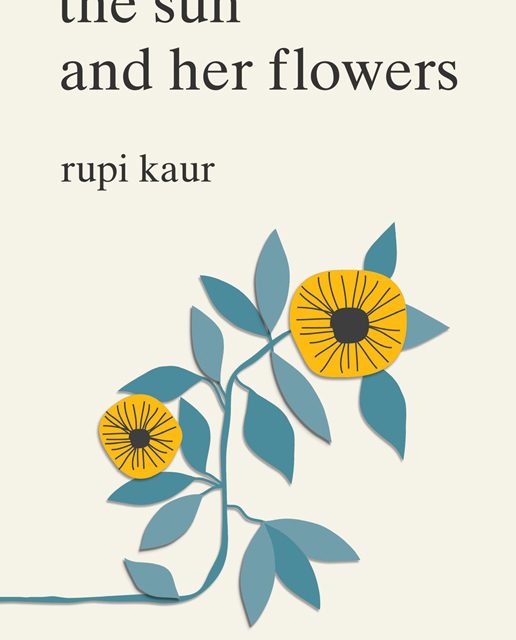‘the sun and her flowers’ is a collection of poetry by Canadian poet Rupi Kaur. It is the follow-up to her debut work ‘milk and honey’ which is an international best-seller that continues to garner sales two years after its release. ‘the sun and her flowers’ has been marketed widely and its release was greatly anticipated by avid fans and critics alike. Published by Simon and Schuster on 3 October of this year, I have been reading my copy since – once all the way through, followed by a dip in and out of various poems. I have managed to avoid most major reviews of the work, as well as the vast amount of social media commentary, so as to keep this review as true to my own opinion as possible.
“‘the sun and her flowers’ is a collection of poetry about grief, self-abandonment, honouring one’s roots, love, and empowering oneself” – so says the blurb. The work is divided into five distinct sections corresponding to these themes titled: wilting, falling, rooting, rising, and blooming. It is a work that can be picked up and opened at random for a quick burst of poetry, or read from start to finish journeying through the developing sections. The paperback copy is affordably priced and well laid out which isn’t as easy as you might think for a style that began life on Instagram. As in ‘milk and honey’, most of the poetic works are accompanied by simple black and white illustrations created by Rupi Kaur herself; an exception is made for the self-effacing illustration on the cover which is in colour.
It is far too easy to assume that each of the five themes contains poetry of a single strand. Upon a cursory reading of ‘wilting’ for example, you’d be forgiven for concluding that the works therein are solely about lost love between two people (destroyed love might be a better depiction) and whilst that is undoubtedly a major element of the section, I did not find that to be all it was about. In ‘the construction site of our future’ for example, I found notions of Stateless-ness, migrant citizenship, and even death. Rupi Kaur may be most well known as a poet who touches upon the pain of violence (sexual or otherwise), and the strength of finding oneself, but her ability to write colourfully about the sacrifices of family, the environment, and consumerism, should not go without mention. Indeed, the work from which the title of this collection is drawn concerns more than the love depicted for a partner, and in my opinion leans towards finding complete and utter devotion to the Divine in order to be truly alive.
It is perhaps my curse (I consider it my boon) that I think of Gurbani when consuming art. This work was no different, but I felt uncomfortable writing such what with Rupi Kaur also being Sikh. I do not wish to identify any of her work as being Gurbani-led or Sikh-inspired (although as a Sikh it is at some level) so take what I am about to say as my personal interpretation: I think a great deal of ‘the sun and her flowers’ focuses on our search for contentment. I found in the early sections a settling for some temporary satisfaction, ruing the decision to do so for what it brings with it, before looking inwards to repair, heal and stand taller despite the experience. The next step in succeeding sections once again seeks love, but although it was presented as true love (or perhaps truer love), it transcended the relationship between people, in my eyes. There is an indication that I am reading into this inaccurately, but I found the ‘blooming’ section had me thinking about the path towards an ultimate realisation (of what life is) littered with maya. Works like ‘unibrow’ and ‘thank you’ contain multiple themes in very few words, if you read them and allow them to digest as I did.
Without doubt, this work is about love, trauma, and female empowerment, but I think there is something more there too which is why Rupi Kaur has become so popular. Poetry is subjective; our interpretations of it differ based on the circumstances we live with and the ideas we formulate of the World around us. Where there are shared experiences from the same poetic work, one can surmise there is likely commonality in certain events that have occurred in the lives of those individuals. It is for this reason I think that I encounter many males who are not fans of Rupi Kaur’s work. They might not hate it, but they consider it “not for them”. In the case of ‘the sun and her flowers’ I would consider that a shame. It is a piece of work that delivers to the reader as much as they are able to put in. I found some of the work to be straightforward, clean on the page as simple as the words being read aloud in my head, and yet at the same time I found complex structures that I have been dissecting ever since; it is quite likely I am reading more into this work than the poet ever intended, but I’ve always thought that was the point of experiencing art – to ask deep and meaningful questions, challenge one’s conceptions, and to grow.
‘the sun and her flowers’ is out now and available at all book retailers.







